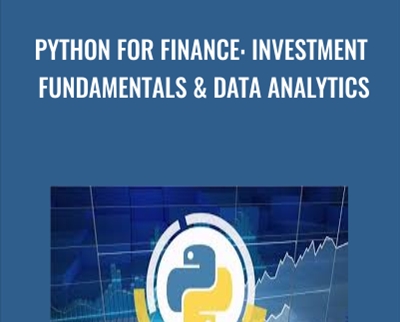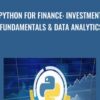$139.99 Original price was: $139.99.$33.00Current price is: $33.00.
We are proud to present Python for Finance: Investment Fundamentals and Data Analytics – one of the most interesting and complete courses we have created so far. It took our team slightly over four months to create this course, but now, it is ready and waiting for you.
 Purchase this course you will earn 33 Points worth of $3.30
Purchase this course you will earn 33 Points worth of $3.30Elevate your skills with the Python for Finance: Investment Fundamentals & Data Analytics course, available for just $139.99 Original price was: $139.99.$33.00Current price is: $33.00. on Utralist.com! Browse our curated selection of over 60,000 downloadable digital courses across diverse Uncategorized. Benefit from expert-led, self-paced instruction and save over 80%. Start learning smarter today!
What you'll learn
- Learn how to code in Python
- Take your career to the next level
- Work with Python’s conditional statements, functions, sequences, and loops
- Work with scientific packages, like NumPy
- Understand how to use the data analysis toolkit, Pandas
- Plot graphs with Matplotlib
- Use Python to solve real-world tasks
- Get a job as a data scientist with Python
- Acquire solid financial acumen
- Carry out in-depth investment analysis
- Build investment portfolios
- Calculate risk and return of individual securities
- Calculate risk and return of investment portfolios
- Apply best practices when working with financial data
- Use univariate and multivariate regression analysis
- Understand the Capital Asset Pricing Model
- Compare securities in terms of their Sharpe ratio
- Perform Monte Carlo simulations
- Learn how to price options by applying the Black Scholes formula
- Be comfortable applying for a developer job in a financial institution
Description
Do you want to learn how to use Python in a working environment?
Are you a young professional interested in a career in Data Science?
Would you like to explore how Python can be applied in the world of Finance and solve portfolio optimization problems?
If so, then this is the right course for you!
We are proud to present Python for Finance: Investment Fundamentals and Data Analytics – one of the most interesting and complete courses we have created so far. It took our team slightly over four months to create this course, but now, it is ready and waiting for you.
An exciting journey from Beginner to Pro.
If you are a complete beginner and you know nothing about coding, don’t worry! We start from the very basics. The first part of the course is ideal for beginners and people who want to brush up on their Python skills. And then, once we have covered the basics, we will be ready to tackle financial calculations and portfolio optimization tasks.
Finance Fundamentals.
And it gets even better! The Finance block of this course will teach you in-demand real-world skills employers are looking for. To be a high-paid programmer, you will have to specialize in a particular area of interest. In this course, we will focus on Finance, covering many tools and techniques used by finance professionals daily:
- Rate of return of stocks
- Risk of stocks
- Rate of return of stock portfolios
- Risk of stock portfolios
- Correlation between stocks
- Covariance
- Diversifiable and non-diversifiable risk
- Regression analysis
- Alpha and Beta coefficients
- Measuring a regression’s explanatory power with R^2
- Markowitz Efficient frontier calculation
- Capital asset pricing model
- Sharpe ratio
- Multivariate regression analysis
- Monte Carlo simulations
- Using Monte Carlo in a Corporate Finance context
- Derivatives and type of derivatives
- Applying the Black Scholes formula
- Using Monte Carlo for options pricing
- Using Monte Carlo for stock pricing
Everything is included! All these topics are first explained in theory and then applied in practice using Python.
Is there a better way to reinforce what you have learned in the first part of the course?
This course is great, even if you are an experienced programmer, as we will teach you a great deal about the finance theory and mechanics you will need if you start working in a finance context.
Teaching is our passion.
Everything we teach is explained in the best way possible. Plain and clear English, relevant examples and time-efficient videos. Don’t forget to check some of our sample videos to see how easy they are to understand.
If you have questions, contact us! We enjoy communicating with our students and take pride in responding within the 1 business day. Our goal is to create high-end materials that are fun, exciting, career-enhancing, and rewarding.
What makes this course different from the rest of the Programming and Finance courses out there?
- This course will teach you how to code in Python and apply these skills in the world of Finance. It is both a Programming and a Finance course.
- High-quality production – HD video and animations (this isn’t a collection of boring lectures!)
- Knowledgeable instructors. Martin is a quant geek fascinated by the world of Data Science, and Ned is a finance practitioner with several years of experience who loves explaining Finance topics in real life and here on Udemy.
- Complete training – we will cover all the major topics you need to understand to start coding in Python and solving the financial topics introduced in this course (and they are many!)
- Extensive Case Studies that will help you reinforce everything you’ve learned.
- Course Challenge: Solve our exercises and make this course an interactive experience.
- Excellent support: If you don’t understand a concept or you simply want to drop us a line, you’ll receive an answer within 1 business day.
- Dynamic: We don’t want to waste your time! The instructors set a very good pace throughout the whole course.
Please don’t forget that the course comes with Udemy’s 30-day unconditional, money-back-in-full guarantee. And why not give such a guarantee, when we are convinced the course will provide a ton of value for you?
Just subscribe to this course! If you don't acquire these skills now, you will miss an opportunity to separate yourself from the others. Don't risk your future success! Let's start learning together now!
Who this course is for:
- Aspiring data scientists
- Programming beginners
- People interested in finance and investments
- Programmers who want to specialize in finance
- Everyone who wants to learn how to code and apply their skills in practice
- Finance graduates and professionals who need to better apply their knowledge in Python
Course content
18 sections • 111 lectures • 8h 15m total length
- Welcome! Course Introduction
- Introduction to programming with Python
- Python Variables and Data Types
- Basic Python Syntax
- Python Operators Continued
- Conditional Statements
- Python Functions
- Python Sequences
- Using Iterations in Python
- Advanced Python tools
- PART II FINANCE: Calculating and Comparing Rates of Return in Python
- PART II Finance: Measuring Investment Risk
- PART II Finance – Using Regressions for Financial Analysis
- PART II Finance – Markowitz Portfolio Optimization
- Part II Finance – The Capital Asset Pricing Model
- Part II Finance: Multivariate regression analysis
- PART II Finance – Monte Carlo simulations as a decision-making tool
- BONUS LECTURE
Get Python for Finance: Investment Fundamentals & Data Analytics – Anonymous, Only Price $37
Tag: Python for Finance: Investment Fundamentals & Data Analytics Review. Python for Finance: Investment Fundamentals & Data Analytics download. Python for Finance: Investment Fundamentals & Data Analytics discount.
Cultivate continuous growth with the Python for Finance: Investment Fundamentals & Data Analytics course at Utralist.com! Unlock lifetime access to premium digital content, meticulously designed for both career advancement and personal enrichment.
- Lifetime Access: Enjoy limitless access to your purchased courses.
- Exceptional Value: Benefit from savings up to 80% on high-quality courses.
- Secure Transactions: Your payments are always safe and protected.
- Practical Application: Gain real-world skills applicable to your goals.
- Instant Accessibility: Begin your learning journey immediately after buying.
- Device Compatible: Access your courses seamlessly on any device.
Transform your potential with Utralist.com!
Related products
Uncategorized
= 85 Points
Uncategorized
Managing Geriatric Behaviors: Wandering, Aggression, Malnutrition and More – Steven Atkinson
= 35 Points
Uncategorized
= 95 Points
= 94 Points
Uncategorized
Cognitive Rehabilitation Therapy: Practical Interventions and Personalized Planning – Jane Yakel
= 85 Points
= 72 Points
Uncategorized
Proven Fall Prevention Strategies: Exercise, Meds Management and Home Modification – Trent Brown
= 40 Points
Uncategorized
= 30 Points





